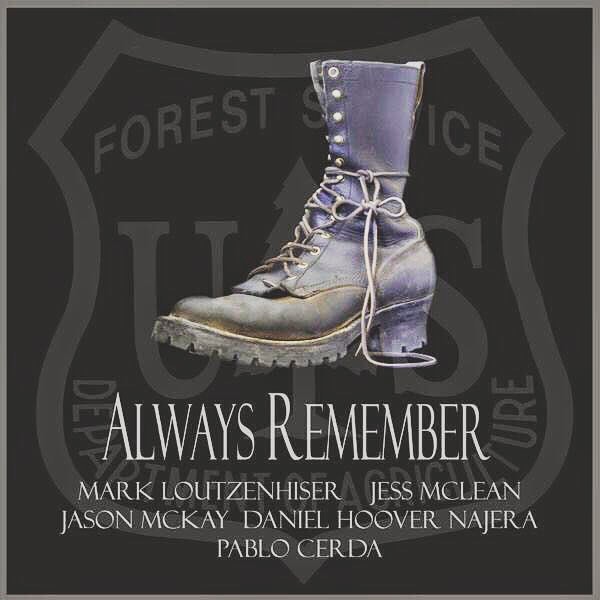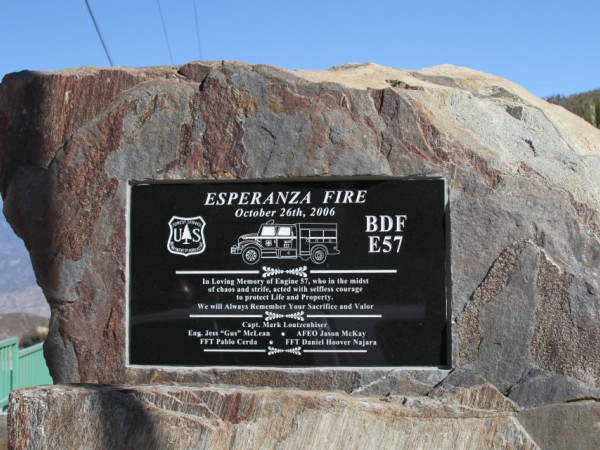Esperanza Fire Recap
This week marks ten years since the tragic Esperanza Fire in California’s Riverside County. The fire started at the base of Cabazon Hill west of Palm Springs around 1:11 a.m. on October 26th, 2006. Moderate Santa Ana conditions quickly pushed the fire uphill and to the west prompting a large mutual aid response. Five United States Forest Service (USFS) Engines (including Engine 57) were some of the first to respond from the San Jacinto Ranger District and were quickly assigned to structure protection in the rural mountain community of Twin Pines. At approximately 7:15 a.m., five wildland firefighters from USFS Engine 57 were overrun by the fire protecting an isolated, vacant residential structure.

Tragedy in Twin Pines
At the time of the accident, the fire was several hundred acres in size and burning rapidly in critically dry fuel, under the influence of Santa Ana winds. A Red Flag Warning was in place for the area, issued twenty hours prior to the accident. A March 2006 Wildfire Protection Plan rated the Twin Pines community’s Fire Threat as Extreme to Very High. Additionally, the “Octagon” house they were protecting was located at the head of a steep drainage and, according to a 2002 study, was given a defensibility rating as “non-defensible”.
Officials later determined that the combination of wind alignment, fuel susceptibility, topography of the steep drainage below the firefighters’ location, and a thermal uplifting at daybreak caused a sudden and intense fire run. Many contributing factors led to their demise, but ultimately the five firefighters were surrounded by fire incredibly quickly, without time for escape, and were fatally burned by it. The Esperanza Fire totaled 40,200 acres and 34 residences burned, continuing for another few days after that fateful morning.
Accident Aftermath
In the wake of the accident, a few investigations ensued, aiming to determine the causal and contributing factors as well as the criminal intent of the fire’s origin itself. A full investigation of the burnover found two main causal factors:
- There was a loss of situational awareness concerning the dangers associated with potential fire behavior and fire environment while in a complex wildland urban interface situation.
- The decision by command officers and engine supervisors to attempt structure protection at the head of a rapidly developing fire either underestimated, accepted, and/or misjudged the risk to firefighter safety.
Arson investigators found the fire’s ignition was an act of arson by a Raymond Lee Oyler, a nearby Beaumont resident and serial arsonist. The individual “was convicted March 6 (2009) of five counts of first-degree murder, 20 counts of arson and 17 counts of using an incendiary device. A jury called for the death penalty.” This was the first and only time an arsonist has been convicted of first degree murder.
Ten days after the event, a public memorial service was held in Devore, CA for the five firefighters lost. Subsequently, California Highway 243 through the Cabazon Hills was named a memorial highway in honor of the fallen firefighters. The site of the accident will remain unoccupied and serve as a permanent remembrance memorial. A book was written by John McClean outlining the events of the Esperanza fire tragedy (as well as other fires). The critically-acclaimed book has been picked up by Legendary Pictures for adaptation for a future film.

Memorial Plaque at the site of the accident
Source(s):
https://en.wikipedia.org/wiki/Esperanza_Fire
http://articles.latimes.com/2009/jun/06/local/me-oyler6
http://www.coloradofirecamp.com/esperanza/narrative.htm
http://www.fire.ca.gov/fire_protection/downloads/esperanza_00_complete_final_draft_05_01_2007.pdf




2 Comments